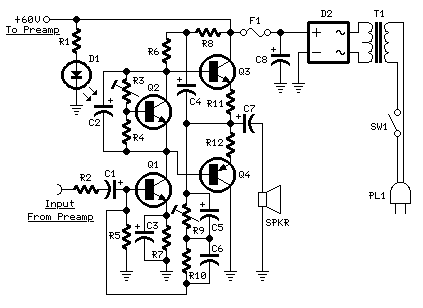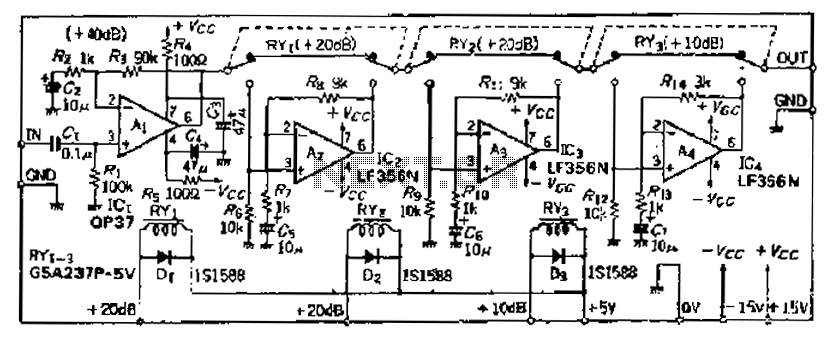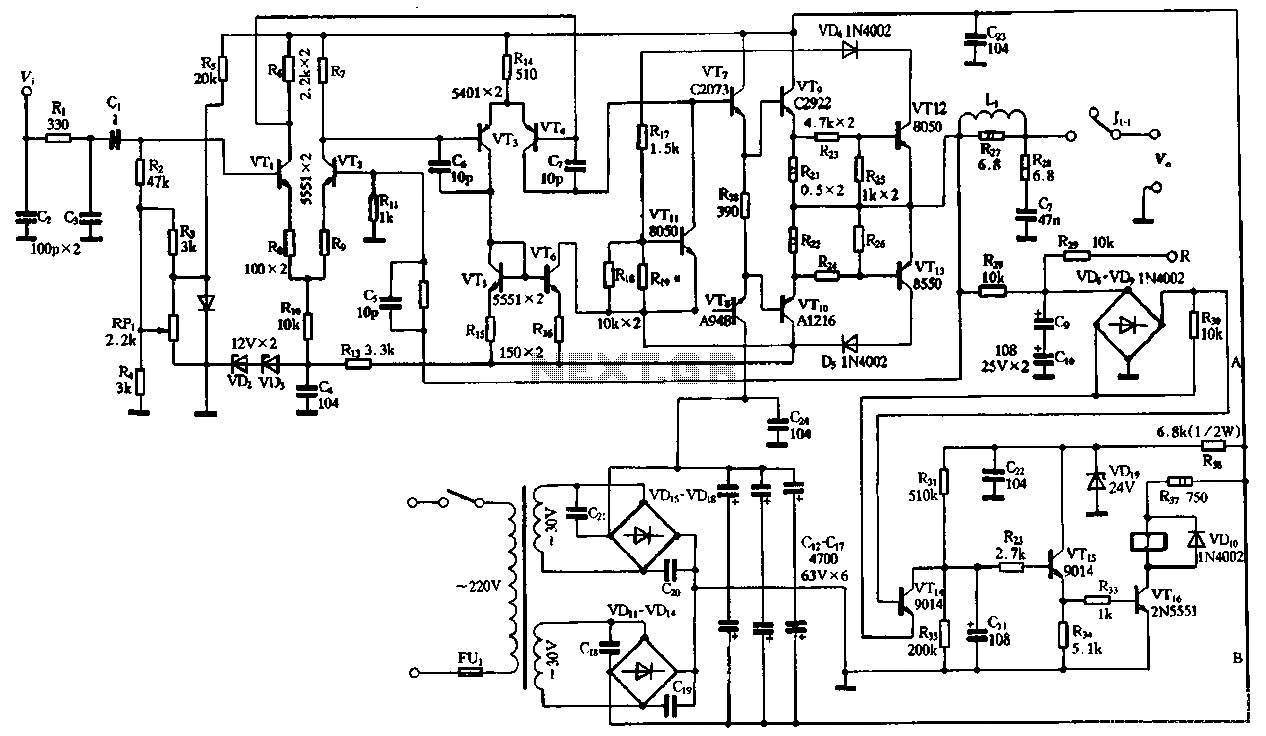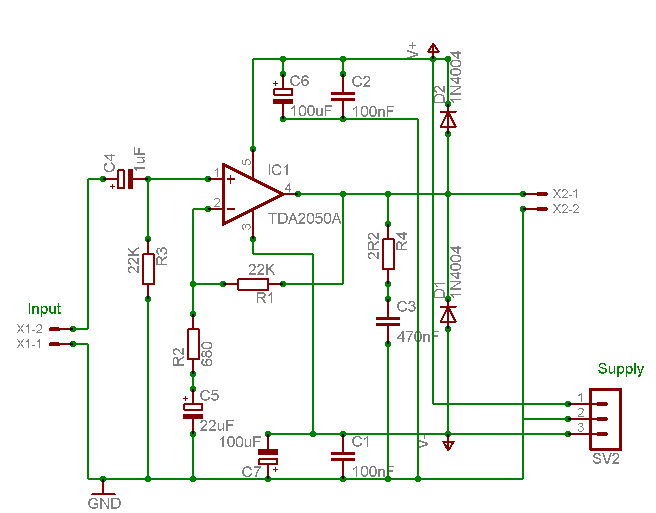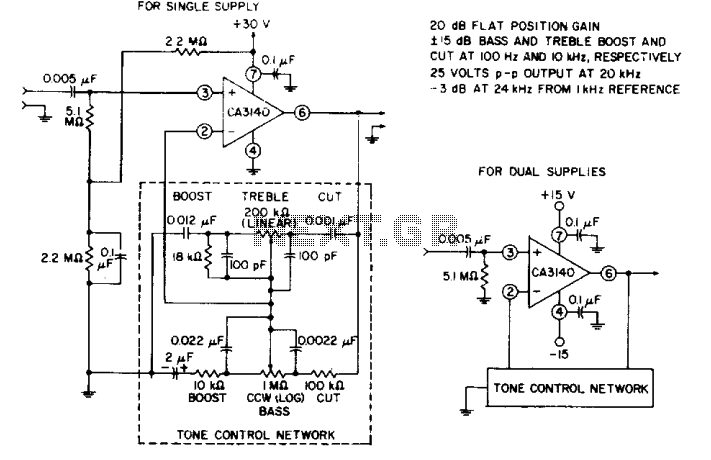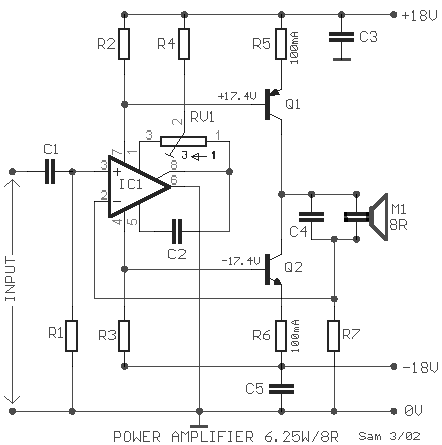
1 Watt 2.3 ghz amplifier
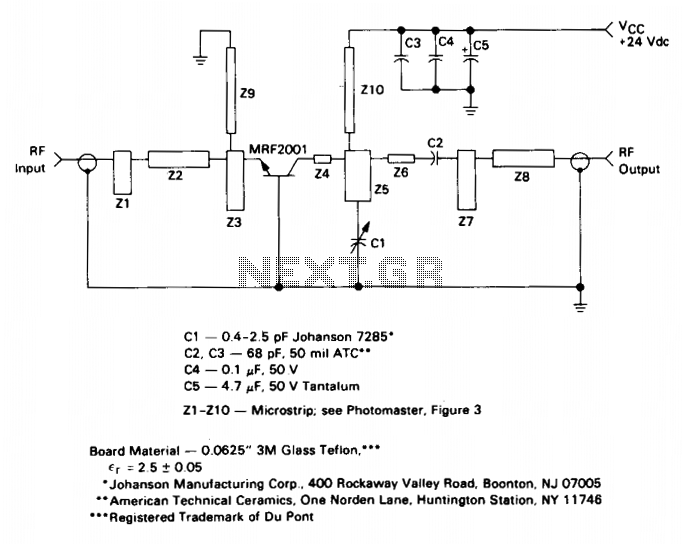
This 1-watt S-band amplifier design emphasizes simplicity and repeatability. It utilizes an MRF2001 transistor configured as a common base, Class C amplifier. The amplifier produces a 1-watt output with a minimum gain of 8 dB at 24 V and is tunable within the frequency range of 2.25 to 2.35 GHz. It is suitable for applications in microwave communications equipment and other systems that require medium power, narrowband amplification. The amplifier's circuitry predominantly consists of distributed microstrip elements, with a total of six additional components, including the MRF2001, necessary for constructing a functional amplifier. The input and output impedances of the transistor are matched to 50 ohms using double-section low-pass networks.
The networks are engineered to deliver approximately 3% 1 dB power bandwidth while achieving a collector efficiency of around 30%. One tuning adjustment is present in the amplifier, specifically at Cl in the output network. Ceramic chip capacitors, designated as C2 and C3, are employed for DC blocking and power supply decoupling, while additional low-frequency decoupling is facilitated by capacitors C4 and C5.
This 1-watt S-band amplifier design is characterized by its efficient use of the MRF2001 transistor in a common base configuration, which is well-suited for Class C operation. The amplifier's ability to deliver a minimum gain of 8 dB at a supply voltage of 24 V is indicative of its robust performance in the specified frequency range of 2.25 to 2.35 GHz. The design is particularly advantageous for applications requiring narrowband amplification, such as in microwave communication systems.
The use of distributed microstrip elements in the circuitry enhances the amplifier's performance by minimizing losses and optimizing the signal integrity across the operational bandwidth. The design's impedance matching to 50 ohms through double-section low-pass networks is crucial for ensuring maximum power transfer and minimizing reflections, which is essential in high-frequency applications.
The bandwidth specification of approximately 3% for the 1 dB power bandwidth indicates the amplifier's capability to maintain consistent performance across a defined frequency range. The choice of a collector efficiency of around 30% reflects a balanced approach between power output and thermal management, which is critical in maintaining the reliability of the amplifier during extended operation.
The tuning capability provided by the adjustment at Cl in the output network allows for fine-tuning of the amplifier's performance, accommodating variations in component tolerances and environmental conditions. The inclusion of ceramic chip capacitors for DC blocking and power supply decoupling (C2 and C3) ensures that the amplifier operates efficiently without unwanted DC offsets or noise. Furthermore, the additional low-frequency decoupling capacitors (C4 and C5) serve to enhance power stability, reducing the risk of oscillations and ensuring that the amplifier maintains its performance characteristics under varying load conditions.
Overall, this amplifier design exemplifies a well-engineered solution for medium power applications in the S-band, combining effective component selection with thoughtful circuit design to achieve desirable performance metrics.Simplicity and repeatability are featured in this 1 watt S-band amplifier design. The design uses an MRF2001 transistor as a common base, Class C amplifier. The amplifier delivers 1 watt output with 8 dB minimum gain at 24 V, and is tunable from 2.25 to 2.35 GHz. Applications include microwave communications equipment and other systems requiring medium power, narrow band amplification.
The amplifier circuitry consists almost entirely of distributed microstrip elements. A total of six additional components, including the MRF2001, are required to build a working amplifier. The input and output impedances of the transistor are matched to 50 ohms by double section low pass networks.
The networks are designed to provide about 3% 1 dB power bandwidth while maintaining a collector efficiency of approximately 30%. There is one tuning adjustment in the amplifier—Cl in the output network. Ceramic chip capacitors, C2 and C3, are used for dc blocking and power supply decoupling. Additional low frequency decoupling is provided by capacitors C4 and C5.
The networks are engineered to deliver approximately 3% 1 dB power bandwidth while achieving a collector efficiency of around 30%. One tuning adjustment is present in the amplifier, specifically at Cl in the output network. Ceramic chip capacitors, designated as C2 and C3, are employed for DC blocking and power supply decoupling, while additional low-frequency decoupling is facilitated by capacitors C4 and C5.
This 1-watt S-band amplifier design is characterized by its efficient use of the MRF2001 transistor in a common base configuration, which is well-suited for Class C operation. The amplifier's ability to deliver a minimum gain of 8 dB at a supply voltage of 24 V is indicative of its robust performance in the specified frequency range of 2.25 to 2.35 GHz. The design is particularly advantageous for applications requiring narrowband amplification, such as in microwave communication systems.
The use of distributed microstrip elements in the circuitry enhances the amplifier's performance by minimizing losses and optimizing the signal integrity across the operational bandwidth. The design's impedance matching to 50 ohms through double-section low-pass networks is crucial for ensuring maximum power transfer and minimizing reflections, which is essential in high-frequency applications.
The bandwidth specification of approximately 3% for the 1 dB power bandwidth indicates the amplifier's capability to maintain consistent performance across a defined frequency range. The choice of a collector efficiency of around 30% reflects a balanced approach between power output and thermal management, which is critical in maintaining the reliability of the amplifier during extended operation.
The tuning capability provided by the adjustment at Cl in the output network allows for fine-tuning of the amplifier's performance, accommodating variations in component tolerances and environmental conditions. The inclusion of ceramic chip capacitors for DC blocking and power supply decoupling (C2 and C3) ensures that the amplifier operates efficiently without unwanted DC offsets or noise. Furthermore, the additional low-frequency decoupling capacitors (C4 and C5) serve to enhance power stability, reducing the risk of oscillations and ensuring that the amplifier maintains its performance characteristics under varying load conditions.
Overall, this amplifier design exemplifies a well-engineered solution for medium power applications in the S-band, combining effective component selection with thoughtful circuit design to achieve desirable performance metrics.Simplicity and repeatability are featured in this 1 watt S-band amplifier design. The design uses an MRF2001 transistor as a common base, Class C amplifier. The amplifier delivers 1 watt output with 8 dB minimum gain at 24 V, and is tunable from 2.25 to 2.35 GHz. Applications include microwave communications equipment and other systems requiring medium power, narrow band amplification.
The amplifier circuitry consists almost entirely of distributed microstrip elements. A total of six additional components, including the MRF2001, are required to build a working amplifier. The input and output impedances of the transistor are matched to 50 ohms by double section low pass networks.
The networks are designed to provide about 3% 1 dB power bandwidth while maintaining a collector efficiency of approximately 30%. There is one tuning adjustment in the amplifier—Cl in the output network. Ceramic chip capacitors, C2 and C3, are used for dc blocking and power supply decoupling. Additional low frequency decoupling is provided by capacitors C4 and C5.
